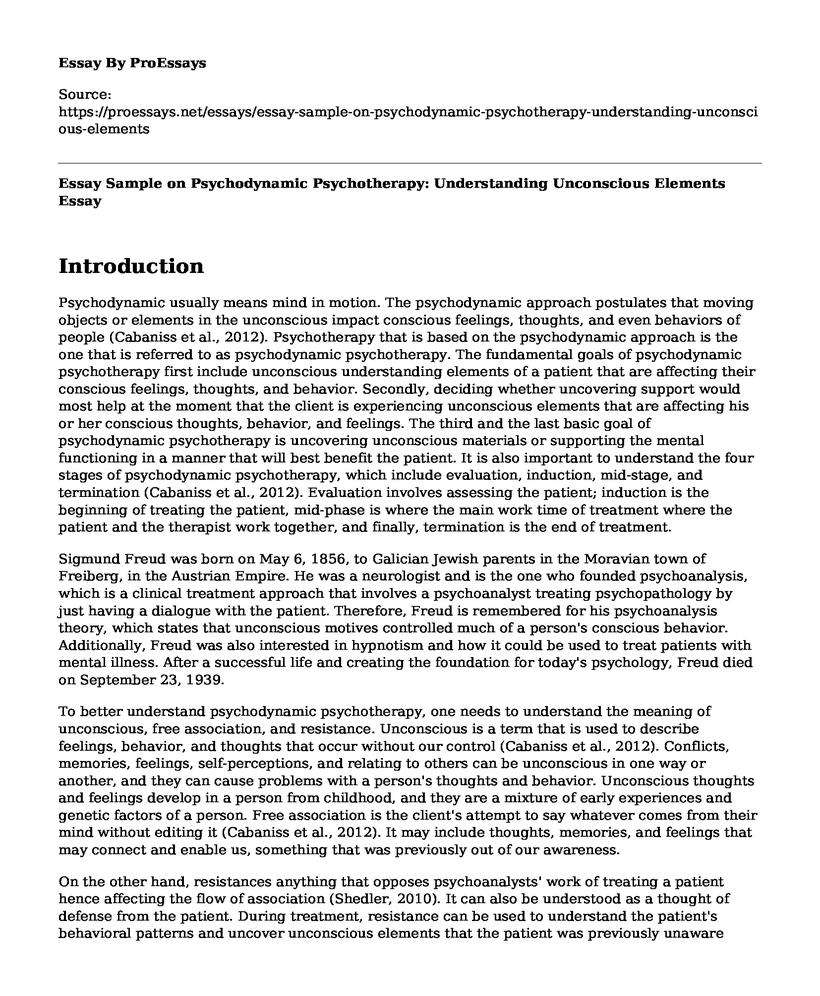Introduction
Psychodynamic usually means mind in motion. The psychodynamic approach postulates that moving objects or elements in the unconscious impact conscious feelings, thoughts, and even behaviors of people (Cabaniss et al., 2012). Psychotherapy that is based on the psychodynamic approach is the one that is referred to as psychodynamic psychotherapy. The fundamental goals of psychodynamic psychotherapy first include unconscious understanding elements of a patient that are affecting their conscious feelings, thoughts, and behavior. Secondly, deciding whether uncovering support would most help at the moment that the client is experiencing unconscious elements that are affecting his or her conscious thoughts, behavior, and feelings. The third and the last basic goal of psychodynamic psychotherapy is uncovering unconscious materials or supporting the mental functioning in a manner that will best benefit the patient. It is also important to understand the four stages of psychodynamic psychotherapy, which include evaluation, induction, mid-stage, and termination (Cabaniss et al., 2012). Evaluation involves assessing the patient; induction is the beginning of treating the patient, mid-phase is where the main work time of treatment where the patient and the therapist work together, and finally, termination is the end of treatment.
Sigmund Freud was born on May 6, 1856, to Galician Jewish parents in the Moravian town of Freiberg, in the Austrian Empire. He was a neurologist and is the one who founded psychoanalysis, which is a clinical treatment approach that involves a psychoanalyst treating psychopathology by just having a dialogue with the patient. Therefore, Freud is remembered for his psychoanalysis theory, which states that unconscious motives controlled much of a person's conscious behavior. Additionally, Freud was also interested in hypnotism and how it could be used to treat patients with mental illness. After a successful life and creating the foundation for today's psychology, Freud died on September 23, 1939.
To better understand psychodynamic psychotherapy, one needs to understand the meaning of unconscious, free association, and resistance. Unconscious is a term that is used to describe feelings, behavior, and thoughts that occur without our control (Cabaniss et al., 2012). Conflicts, memories, feelings, self-perceptions, and relating to others can be unconscious in one way or another, and they can cause problems with a person's thoughts and behavior. Unconscious thoughts and feelings develop in a person from childhood, and they are a mixture of early experiences and genetic factors of a person. Free association is the client's attempt to say whatever comes from their mind without editing it (Cabaniss et al., 2012). It may include thoughts, memories, and feelings that may connect and enable us, something that was previously out of our awareness.
On the other hand, resistances anything that opposes psychoanalysts' work of treating a patient hence affecting the flow of association (Shedler, 2010). It can also be understood as a thought of defense from the patient. During treatment, resistance can be used to understand the patient's behavioral patterns and uncover unconscious elements that the patient was previously unaware (Cabaniss et al., 2012). This boosts the flow of association between the psychoanalyst and the patient reducing resistance from the patient.
Based on how the psychodynamic approach of psychotherapy works, I feel it has been a useful tool by all the psychologists and psychoanalysts as they can apply it to cure their patients by just making conscious their unconscious feelings thoughts. It will help the patients to gain insight by repressing their emotions and experiences by making unconscious conscious and vice versa. Therefore, I believe the psychodynamic approach is still useful and effective in the field of psychology.
References
Cabaniss, D. L., Cherry, S., Douglas, C. J., & Schwartz, A. R. (2012). Psychodynamic Psychotherapy: a Clinical Manual. http://www.iuc.hr/IucAdmin/Server/downloads/CabanissPsychodynamicPsychother.pdf
Shedler, J. (2010). The efficacy of psychodynamic psychotherapy. American psychologist, 65(2), 98. https://www.apa.org/pubs/journals/releases/amp-65-2-98.pdf
Cite this page
Essay Sample on Psychodynamic Psychotherapy: Understanding Unconscious Elements. (2023, May 22). Retrieved from https://proessays.net/essays/essay-sample-on-psychodynamic-psychotherapy-understanding-unconscious-elements
If you are the original author of this essay and no longer wish to have it published on the ProEssays website, please click below to request its removal:
- The Relationship Between Unemployment, Physical Health, and Mental Health
- Paper Sample on Mental Health Disasters: How Social Psychology Helps Understand Causes
- Essay Sample on Exercise Effectiveness for ADHD: Analysis of Symptoms in Children/Adolescents
- Essay on 7 Tips for Resident Doctors to Handle Stress and Remain Organized
- Cassandra's Mental Disorders: Psychotherapy as Best Treatment - Essay Sample
- Paper Example on Managing Postpartum Depression: Coping Style & Prevalence Rates
- War on Compassion: The Impact of Massification - Free Report Sample







